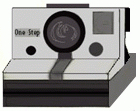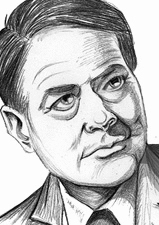Edwin Land
Have you ever used a Polaroid camera? The portable device allows you to snap a photo, which is then printed straight out of the camera itself in seconds. This is all thanks to the work of Edwin Herbert Land. Land was born in Bridgeport, Connecticut on May 7, 1909 and attended the Norwich Free Academy, graduating in 1927. Following high school, he attended Harvard University where he conceived and produced the first modern filters to polarize light, patented in 1929. But it was through his Polaroid Corporation (founded in 1937) that Land was immortalized, for his invention and marketing of instant photography.
It was 1943 when his three-year-old daughter had asked him why she couldn't see a photo he had taken of her right away. Inspired, Land ended up creating a system of one-step photography: A camera that instantly printed photographs the moment they were captured.
In 1947, Land demonstrated the instant camera at the Optical Society of America’s winter meeting. Land used the principle of diffusion transfer to reproduce the image recorded by the camera's lens directly onto a photosensitive surface. The Polaroid Land Camera Model 95 (Patent #2,543,181) was first offered for sale on November 26, 1948. Following this success, Land continued to improve his invention, eventually creating his color film, "Polacolor” in 1963.
His revolutionary "SX-70" camera, introduced in 1972 replaced the wet, peel-apart development process with dry films that developed in light. It was the first device to use an instant film pack combined with a built-in battery. Land even created an instant color movie-making system, "Polavision," in 1978, but this never enjoyed the commercial success of his still-photography cameras.

Land spent his entire adult life experimenting and innovating in the field of optics, from producing recording systems used by the U.S. in World War II to proposing the "retinex" theory of human color perception. His “retinex” theory said that all visual levels of processing, from the retina in the eye to the visual cortex in the brain were necessary for human beings to process color. Over his lifetime he was issued over 500 U.S. patents and was awarded the Medal of Freedom in 1963—the highest honor granted to civilians in the U.S.
Although he ended up dropping out of Harvard, Land received honorary degrees from Harvard, Yale and Columbia and was inducted into the National Inventors Hall of Fame in 1977. Three years later, he resigned as chairman of Polaroid and founded the Rowland Institute for Science at Harvard University (now the Rowland Institute at Harvard). In 1988, he received the National Medal of Technology.
Land passed away on March 1, 1991. The following year, the Optical Society and the Society for Imaging Science and Technology established the Edwin H. Land Medal in recognition of his contributions to the field of optics.


